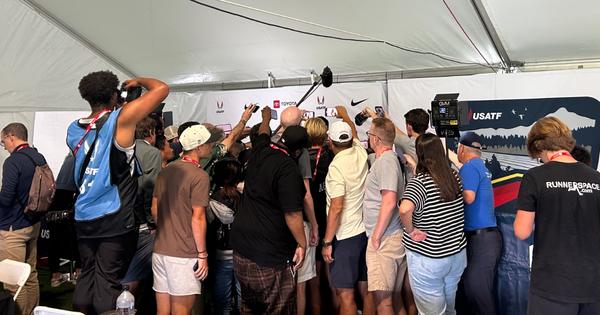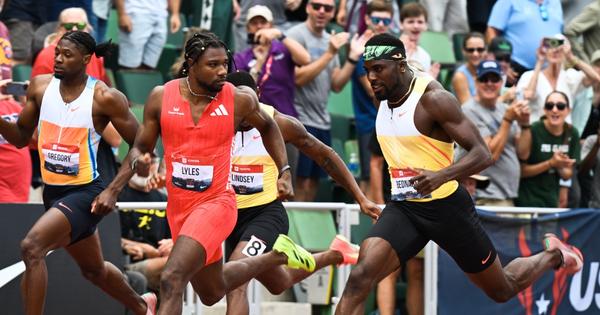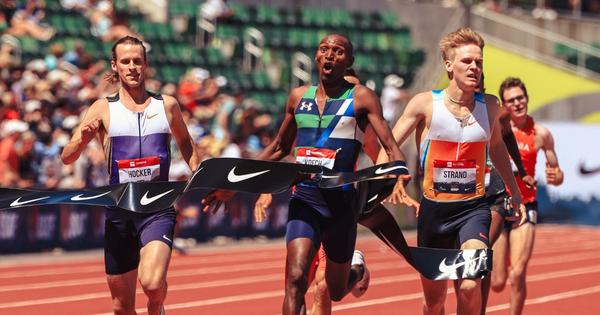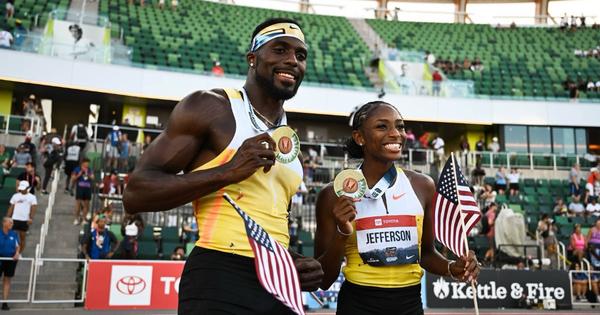By Keenan Baker
August 6, 2025
All summer, CITIUS MAG intern Keenan Baker has been crushing our meet coverage from Eugene to Europe and everywhere in between. So we sent him back into the lion’s den of the USAs mixed zone to not only get dozens of interviews, but report back on what it’s really like for sports journalists in the shadow of Hayward Field:
One of the oldest adages in sports journalism is “no cheering in the press box.” Honestly, there’s no way I followed that rule to the letter this weekend—but can you blame me? This was my first time in a multi-day championship mixed zone, and so I’m sharing a little about the experience on-theme, in rapid-fire Q&A form.
What is a “mixed zone”?
It’s a space where any and everybody who’s a part of the media at a track meet resides. Some people work independently, others have a full crew. All are there to interview athletes, edit pictures, or write articles. Have a press pass? This is the office.
Why is it so important?
Another piece of common journalism wisdom is “go where the story is.” The mixed zone is the base of track & field content, and at a meet like USAs, even the most press-averse athletes HAVE to show up and talk to us. So it’s on us, as media, to make the most of the opportunity. Want to know why someone won—or lost—their events? Don’t be scared; just ask. It’s minutes-long rapid-fire questioning of anyone from Noah Lyles to Colin Sahlman to Helen Schlachtenhaufen.
Is it inside the stadium, outside of it? On the roof?
In Eugene, it’s just off the west side of Hayward Field, smushed together under one half of a half of a tent. There’s usually an information desk on the left (with a printer!) and a TV so that us media members can still “watch” the meet. To the right of the TV are six tables, with charging ports for the six to eight media members that choose to sit down. Barely anyone sits down, though.
Do athletes have to walk through the mixed zone or is it just whoever wants to?
Every athlete decompresses in another tent before they go in the mixed zone, but they all technically have to mosey through (barring any sort of medical issue or other extenuating circumstances). This is a huge part of why meets like USAs and Worlds are such a big deal for us as media and fans—it guarantees access to athletes that may be harder to track down or less likely to chat at other points in the season.
Do they ever not stop?
Yeah, and that’s pretty normal. If I had a bad race, I wouldn’t want to talk to strangers hellbent on grilling me about my emotions. With that in mind, I’m pretty grateful when anybody stops.
What did you think it would be like?
I’d been in the mixed zone for Pre Classic, the Paris Diamond League, and NCAAs, but focused more on writing recaps than racking up interviews. I figured a meet of this size would be chaos—a free-for-all fight for content and space. And I wasn’t wrong. No physical fights in the mixed zone, but it got close a couple times.
How much room do you have?
It’s SMALL.
Approximately, unscientifically, 20 individuals shoulder-to-shoulder, would span the entire width of the mixed zone where people interview athletes. Smallest mixed zone of the year thus far. But no one actually stands next to each other, because multiple athletes are in the mixed zone at the same time, and when an athlete like Sha’Carri Richardson comes through, everyone crowds around.
You can’t hear unless you’re within about five feet, because someone else might walk in and start chatting right next to you. And—as I’m sure you can imagine—a lot of people talk quietly after competing. We may be cramped and our phones may be low on battery, but we didn’t run 10,000m.
How do you come up with questions?
Mixed-zone interviews are rarely truly one-on-one—you’re usually trading off questions with other journalists, and trying to find your moment to butt in without interrupting the athlete or your colleagues. It can be as stressful and adrenaline-inducing as racing—but way less physically taxing for those of us on the journalism side of the railing.
There are definitely unspoken expectations about what’s “fair game.” Generally, it’s best practice to start with talking about the race itself, but inevitably other topics get raised as well. We also become familiar faces to the athletes on the circuit, so sometimes you have to be tactical about what questions you ask. We all want the juicy scoop or the viral moment, but if you push too hard or get on an athlete’s bad side, they might walk right past you next time.
Are there sections, or do some people try to hog all the space?
Most people try not to get in other people’s way, and it’s never intentional to box people out, but you’ve got to thread the needle to record the best video. Sometimes, the greedier outlets bring a tripod and put it in the middle (not naming names, but you can probably guess) or at a meet as big as USAs, TV stations set up the biggest cameras imaginable.
Is it awkward when someone doesn’t do well? Do people want to interview them still or is it just silent?
Sometimes, it can be very weird. A lot of silence, peppered with the occasional “Good race.” But when an athlete does want to talk after a tough effort, those can be the most interesting and emotional moments of all.
It’s a lot of mental conflict, though, because stopping and interviewing someone means you might miss another interview, and higher places/bigger names often take precedence. Time and space are exceedingly finite in the mixed zone. It’s nothing personal if someone walks through and doesn’t get interviewed. It’s challenging not to ask for everyone’s story, but focus is important when resources are limited.
Best mixed-zone moment during USAs?
I can think of three off the top of my head:
- Interviewing Evan Jager after the steeplechase prelims. It was one of my first interviews, and potentially one of his last at this level. It almost made me tear up.
- Most people who get into track and field journalism are fans themselves. The mixed zone’s collective reaction to Men’s 800m, transcribed: Josh-is-insane-for-that-forty-nine—Donovan’s-good—Brandon-get-off-the-rail—look-at-Donovan—wait-Cooper-has-a-chance—Cooper’s-moving-Cooper’s-flying—what-the-hell-is-going-on—Cooper-could-make-the-team—WHAT-THE-HELL-JUST-HAPPENED—whats-the-time—ONE-FORTY-TWO-TWENTY-SEVEN—ARE-YOU-KIDDING-ME.
- Athletes being on-camera during other dramatic moments can also be entertaining… like Rai reacting live to Noah and Kenny.
Did you like it overall?
8.5/10. Points off for WiFi/power out on last day and cramped space (but only 1.5 points off! Pretty good!) I may not be able to watch the meet in real time most of the day, but I get to talk about it with some of the biggest track nerds in the biz—competitors and media alike. That final day alone made it all worth it—what a meet.
Would you do it again?
I don’t care how tired I am, if I did that fifty days in a row I’d be happy. What a rush.
Did you cheer in the press box?
I don’t know about the press box, but I sure as hell cheered in the mixed zone. Give me a JIU (Journalism Integrity Unit) violation, I don’t care.

Keenan Baker
Keenan Baker is a track fan. He’s also a journalism major and writer at UNC-Chapel Hill. Putting both of those passions on the page together is the goal, and he looks forward to covering more track and field with CITIUS MAG this summer!




